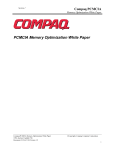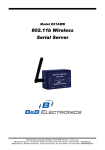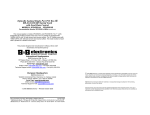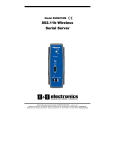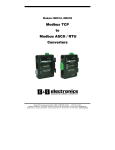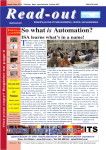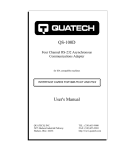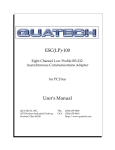Download Bay Technical Associates Fiber Media Adapter Network Card User Manual
Transcript
Not Recommended for New Installations. Please contact Technical Support for more information. PCMCIA High Speed Serial Card CE Model 232HSPCC Documentation Number 232HSPCC1199 International Headquarters B&B Electronics Mfg. Co. Inc. 707 Dayton Road -- P.O. Box 1040 -- Ottawa, IL 61350 USA Phone (815) 433-5100 -- General Fax (815) 433-5105 Home Page: www.bb-elec.com Sales e-mail: orders -- Fax (815) 433-5109 Technical Support e-mail: [email protected] -- Fax (815) 433-5104 European Headquarters B&B Electronics Ltd. Westlink Commercial Park, Oranmore, Co. Galway, Ireland Phone (353) 91 792444 -- Fax (353) 91 792445 Home Page: www.bb-europe.com Sales e-mail: [email protected] Technical Support e-mail: [email protected] February 1999 -- B&B Electronics November 1995 B&B Electronics RESERVED. No part of this publication may be reproduced or transmitted in any form or by any means, electronic or mechanical, including photography, recording, or any information storage and retrieval system without written consent. Information in this manual is subject to change without notice, and does not represent a commitment on the part of B&B Electronics. B&B Electronics shall not be liable for incidental or consequential damages resulting from the furnishing, performance, or use of this manual. All brand names used in this manual are the registered trademarks of their respective owners. The use of trademarks or other designations in this publication is for reference purposes only and does not constitute an endorsement by the trademark holder. Documentation Number 232HSPCC1199 Manual Cover Page B&B Electronics Mfg Co Inc – 707 Dayton Rd - PO Box 1040 - Ottawa IL 61350 - Ph 815-433-5100 - Fax 815-433-5104 B&B Electronics Ltd – Westlink Commercial Park – Oranmore, Galway, Ireland – Ph 353-91-792444 – Fax 353-91-792445 Table of Contents INSTALLATION ....................................................................................... 1 INTRODUCTION ......................................................................................... 1 DOS AND WINDOWS 3.X INSTALLATION .................................................. 1 Installing the Serial Card..................................................................... 1 Configuring the Serial Card ................................................................ 2 Software Setup...................................................................................... 2 Card and Socket Service Users............................................................ 2 Point Enabler Users............................................................................. 3 Using the Point Enabler Program ....................................................... 3 WINDOWS 9X INSTALLATION.................................................................... 5 Installing a 232HSPCC in Windows 9x. .............................................. 6 232HSPCC Resource Settings in Windows 9x..................................... 7 APPENDIX A ......................................................................................... A-1 CARD SPECIFICATIONS.......................................................................... A-1 CABLE PINOUT DIAGRAMS ................................................................... A-2 WARRANTY .......................................................................................... A-3 FCC PART 15 COMPLIANCE ................................................................. A-4 APPENDIX B: DECLARATION OF CONFORMITY .................... B-1 Documentation Number 232HSPCC1199 Manual Table of Contents B&B Electronics Mfg Co Inc – 707 Dayton Rd - PO Box 1040 - Ottawa IL 61350 - Ph 815-433-5100 - Fax 815-433-5104 B&B Electronics Ltd – Westlink Commercial Park – Oranmore, Galway, Ireland – Ph 353-91-792444 – Fax 353-91-792445 i Installation Introduction Congratulations on your purchase of B&B Electronics’ High Speed Serial Card. We are pleased to have you as a customer and are proud to be shipping you a quality PCMCIA product. You are now the owner of a serial card that will give you years of error free service. The built-in 16650 UART (Universal Asynchronous Receiver / Transmitter) ensures error free data communications at speeds up to 460k bits per second. Once the serial card is set up and configured, it will be recognized as a COM port (1-4) by the communication software running on your machine. DOS and Windows 3.x Installation In most notebooks, the B&B Electronics’ Serial Card will be recognized and configured as soon as you insert the card into a free PCMCIA socket. If your notebook or desktop does recognize the Serial Card automatically, you can treat the card exactly the same as a DOS COM port. If the Serial Card is not recognized automatically, you should check with your manufacturer to see if your machine is loading the Card and Socket Service programs correctly. There may be a later version of Card and Socket Services available for your machine. Installing the Serial Card To install your Serial Card into your PCMCIA computer do the following: 1. Locate the PCMCIA socket on your computer. (Refer to your PC users guide if needed.) 2. With the product logo facing up (reference to B&B Electronics) and the 68-pin connector facing the PCMCIA socket, insert the card into the socket. Push firmly to fully engage the RS-232 cable into the exposed side of the Serial Card. 3. Any standard serial device may now be plugged into the 9-pin D connector. NOTE: Refer to the section of the manual labeled Serial Card Setup Examples. Documentation Number 232HSPCC1199 Manual PCMCIA Card B&B Electronics Mfg Co Inc – 707 Dayton Rd - PO Box 1040 - Ottawa IL 61350 - Ph 815-433-5100 - Fax 815-433-5104 B&B Electronics Ltd – Westlink Commercial Park – Oranmore, Galway, Ireland – Ph 353-91-792444 – Fax 353-91-792445 1 Configuring the Serial Card Once the Serial Card has been inserted, the PCMCIA socket must be configured for serial port operation. All PCMCIA input/output devices must be configured by software before they can be used. This configuring/enabling process must be repeated (that is, the enabling program must be run again) whenever the Card is powered off, then on again. A PCMCIA Serial Card will be powered off when the user removes it from the laptop and then reinserts it. It may also be powered off, when the laptop goes into a "sleep" mode to conserve power. There are two kinds of PCMCIA enabling software: Card and Socket Services, and Point Enablers. You must choose which software enabling method you will use to activate your Serial Card. Each method has its advantages and disadvantages. (See Card and Socket Service Users section or Point Enabler Users section for more information.) Most laptops and desktops, that come equipped with PCMCIA slots, come with Card and Socket Services (CSS) software. This software manages the PCMCIA ports. If Card and Socket Services are running on your machine, your Serial Card will be set up and configured for you automatically when you insert the card into the PCMCIA slot. This is usually the easiest and best way to configure your Card. In most cases all you will need to do is plug in your Serial Card and access the assigned COM port. (Refer to your PC documentation for information concerning the Card and Socket Services provided with your system.) Software Setup Once your card is configured, it can be accessed through your application software by choosing the appropriate COM port. (Refer to the users manual associated with the software you are using for information on how to assign COM ports.) Card and Socket Service Users Card and Socket Services is a set of programs which are installed so that they are executed when the laptop is turned on. The Card and Socket Service programs then stay resident - they remain in memory all of the time. Card and Socket Services are designed to detect when a PCMCIA device has been inserted or powered off and then it automatically re-enables the device. This allows "hot swapping" - you can pull a PCMCIA card out and put in a different one and the new card is automatically enabled. Card and Socket Services also "know" how to enable a variety of devices from different manufacturers and attempt to prevent all conflicts between different PCMCIA cards. 2 PCMCIA Card Documentation Number 232HSPCC1199 Manual B&B Electronics Mfg Co Inc – 707 Dayton Rd - PO Box 1040 - Ottawa IL 61350 - Ph 815-433-5100 - Fax 815-433-5104 B&B Electronics Ltd – Westlink Commercial Park – Oranmore, Galway, Ireland – Ph 353-91-792444 – Fax 353-91-792445 The main disadvantage of using Card and Socket Services are that they permanently occupy a certain amount of laptop or desktop memory, which could be used by other programs. Most Card and Socket Service programs are loaded from the CONFIG.SYS file and use from 40K to 85K of memory space. If Card and Socket Services is running properly on your machine, then your Serial Card will be recognized and configured properly by simply inserting the card into one of the PCMCIA slots. Point Enabler Users Point Enablers are programs that run, enable a specific device (such as your B&B Electronics Serial Card), and exit. Point Enabler commands are typically installed in the AUTOEXEC.BAT file so that they will be executed once each time the laptop or desktop is turned on. The advantage of a Point Enabler, is that it uses system memory only while it runs. The disadvantage is that when the PCMCIA device is powered off, the user must remember to execute the Point Enabler command to re-enable the Serial Card. Another disadvantage in using Point Enablers is that you need a different one for each manufacturer's PCMCIA device. One manufacturer's Point Enabler may conflict with another's Point Enabler. A Point Enabler program may also conflict with an already running Card and Socket Service program. It is best NOT to run a Point Enabler if Card and Socket Services have already been loaded on your PC. Using the Point Enabler Program B&B Electronics has supplied a Point Enabler program called ENABLE.EXE. To use this program perform the following: 1. Copy the file “ENABLE.EXE” from the supplied diskette onto your root directory. (Typing ENABLE /? on the command line will bring up a program help screen.) 2. Use a text editor to add the following line to your AUTOEXEC.BAT file: ENABLE /com2 /sA /MD000 Documentation Number 232HSPCC1199 Manual PCMCIA Card B&B Electronics Mfg Co Inc – 707 Dayton Rd - PO Box 1040 - Ottawa IL 61350 - Ph 815-433-5100 - Fax 815-433-5104 B&B Electronics Ltd – Westlink Commercial Park – Oranmore, Galway, Ireland – Ph 353-91-792444 – Fax 353-91-792445 3 NOTE: Putting the above line in your AUTOEXEC.BAT file will cause the Enable program to run each time you reboot or turn your PC on. Do not add this line if Card and Socket Service programs are being used. The "/com#" switch indicates what COM port you want your Serial Card to be set up on. If you want COM4 instead of COM2, you would use the following: ENABLE /com4 /sA /MD000 The "/s" switch indicates which PCMCIA slot contains your Serial Card. If you wanted slot B instead of slot A, you would use the following: ENABLE /com2 /sB /MD000 (On machines with more than one slot, there is no standard way to distinguish which port will be A and which will be B. Usually they are not labeled. You may need to find out through trial and error.) The "/M" switch indicates what memory window the ENABLE program will use for communication with your Serial Card. The four-character number following the /M is a hexadecimal address. If you have a memory conflict at the default D000 range, you could change it to something else. For example, if you wanted D800, you would enter: ENABLE /com2 /sA /MD800 3. 4 If you are not using an expanded memory manager such as EMM386.SYS, skip to step 4. If you are using an expanded memory manager such as EMM386.SYS, you must exclude the memory range you specified in step 2. (Each expanded memory manager has a command line switch that allows you to exclude a range of memory addresses from the memory manager's control. See your memory manager documentation for the exact form of the command line switch.) If you used the default D000 in step 2, you must exclude the range D000-D3FF; if you used D800, you must exclude D800-DBFF, etc. If you are using an expanded memory manager before you run Microsoft Windows, you must also add an "EMMExclude" line to the [386Enh] section of your SYSTEM.INI file to inform Windows of the excluded range. For example: PCMCIA Card Documentation Number 232HSPCC1199 Manual B&B Electronics Mfg Co Inc – 707 Dayton Rd - PO Box 1040 - Ottawa IL 61350 - Ph 815-433-5100 - Fax 815-433-5104 B&B Electronics Ltd – Westlink Commercial Park – Oranmore, Galway, Ireland – Ph 353-91-792444 – Fax 353-91-792445 [386Enh] ... EMMExclude=D000-D3FF ... 4. If you are using Windows 3.1, you may want to use a highspeed COMM driver instead of the standard COMM driver shipped with Windows. (Do not make this change if you are using Windows for Workgroups.) In your Windows SYSTEM.INI file, replace the line in the [boot] section that reads comm.drv=comm.drv with comm.drv=New High Speed Driver Refer to your software vendor for a new high speed COMM driver. This is optional and will allow your Serial Card to perform reliably in Windows at higher speeds. 5. With your Serial Card inserted in a PCMCIA slot, it should now be configured and set up each time you turn on or reboot your PC. Note that since ENABLE.EXE is a Point Enabler, you will need to re-run the ENABLE command line with the appropriate switches each time your laptop goes to sleep or each time you remove and re-insert the Serial Card. NOTE: The ENABLE.EXE program does not support all PCMCIA controller types out on the market. It will work on all controllers that are compatible with the Intel 82365 PCMCIA controller. NOTE: The IBM 360 and 755/755C do not allow the range D000-D3FF to be used. We recommend using the range C800CBFF instead. Windows 9x Installation To allow easy configuration of the 232HSPCC, a Windows 9x "INF" configuration file has been included on the distribution diskette. This file provides all of the setup information required by Windows 9x to allocate resources for the card. The 232HSPCC installation procedure differs slightly between versions of Windows 9x. In either case, the first step is to supply Windows 9x with the .inf configuration files supplied on the 232HSPCC disk. Documentation Number 232HSPCC1199 Manual PCMCIA Card B&B Electronics Mfg Co Inc – 707 Dayton Rd - PO Box 1040 - Ottawa IL 61350 - Ph 815-433-5100 - Fax 815-433-5104 B&B Electronics Ltd – Westlink Commercial Park – Oranmore, Galway, Ireland – Ph 353-91-792444 – Fax 353-91-792445 5 Installing a 232HSPCC in Windows 9x. The following procedure is used to configure a 232HSPCC for use with Windows 9x: 1. 2. 3. 4. 5. 6. Insert the 232HSPCC into any available PC Card socket. The first time a new PC Card type is installed, either the New Hardware Found window or the Update Device Driver Wizard window is displayed. After the initial installation, Windows 9x will automatically detect and configure the card. If neither window is displayed, skip to the section "232HSPCC Resource Settings". If your version of Windows displays the New Hardware Found window, select the Driver from Disk option button and click OK to continue. An Install From Disk dialog box should open. Insert the 232HSPCC disk, select the correct drive letter (generally A:), and click the OK button. Windows 9x automatically browses the root directory for an INF file that defines configurations for the new hardware. If your version of Windows displays the Update Device Driver Wizard window, insert the 232HSPCC disk into the A: or B: drive and click Next. Windows 9x automatically browses the root directory of A: and B: for an INF file that defines configurations for the new hardware. Windows 9x will report that is has found the driver for the device. Click Finish to complete the installation. During the installation, it may be necessary to supply the Windows 9x CD or installation disks. Two drivers are required for serial devices, SERIALUI.DLL and SERIAL.VXD. In many cases, these files are already installed on the host computer. If this is the case, click “OK” when prompted for disks and select the “skip” option. The version of these files that exists in the Windows system directory will be used. Windows 9x socket services should indicate the 232HSPCC PCMCIA card configuration by a low-high tone beep. The 232HSPCC should now be configured. Windows 9x automatically assigns the 232HSPCC to the first available COM port number. For detailed configuration information read the "232HSPCC Resource Settings" section. In the future, Windows 9x will automatically recognize and configure the 232HSPCC in this default configuration. The 232HSPCC will default to low speed mode when installed. To set the card to high speed click on the B&B HIGH SPEED RS-232 PC CARD under the PORTS in the DEVICE MANAGER. Click on the HIGH-SPEED tab, then select 1x or 4x mode, and click on apply. 6 PCMCIA Card Documentation Number 232HSPCC1199 Manual B&B Electronics Mfg Co Inc – 707 Dayton Rd - PO Box 1040 - Ottawa IL 61350 - Ph 815-433-5100 - Fax 815-433-5104 B&B Electronics Ltd – Westlink Commercial Park – Oranmore, Galway, Ireland – Ph 353-91-792444 – Fax 353-91-792445 232HSPCC Resource Settings in Windows 9x To view and/or edit hardware devices in Windows 9x, use the system Device Manager. Consult Windows 9x on-line help for details on the use of the Device Manager. 1. Open the Windows 9x System Properties window. To access the System Properties window double click the System icon in the Windows 95 control panel, or click the My Computer icon on the Windows 95 desktop with the right mouse button and select Properties from the pull down menu. 2. Click the Device Manager tab located along the top of the System Properties box. This lists all hardware devices connected to your computer. Configuration information is available on any of these devices via the Properties command button. 3. Double click the device group Ports (COM and LPT). The 232HSPCC device name should appear in the list of adapters. 4. Click the 232HSPCC’s device name and then click the Properties button to open a Port Properties box for this hardware adapter. 5. Click the Resources tab located along the top of the properties box. 6. The current address and interrupt configuration assigned by Windows 95 is shown in this window. Several predefined Basic Configurations have been included allowing easy selection of different configurations that match standard serial port settings. 7. When selecting a different basic configuration from the "Setting based on list" pay attention to the Conflicting device list information. Try to select a configuration that displays "No conflicts". If resource conflicts can be resolved by switching to one of the predefined basic configurations then skip down to the last step. 8. To modify any of the system resources showing a conflict click the resource name and click the Change Setting button. An Edit Resource window will open up. Note that basic configuration 7 must be selected to modify the I/O address resource. 9. Inside the Edit Resource window click on the up/down arrows to the right of the resource value. This scrolls you through all of the allowable resources for the 232HSPCC. Pay attention to the conflict information at the bottom of the window. Select a resource value that reports "No devices are conflicting". Click OK to save your changes, or Cancel to abort. 10. Repeat the above steps to resolve of resource conflicts. Once satisfied with the settings make a note of the new settings and click the OK button to accept. Clicking the Cancel button does not save your changes. 11. The 232HSPCC will automatically be reconfigured to the new resources specified. Any time the 232HSPCC is inserted Windows 95 will attempt to configure the card at these resource settings. Click the Use Automatic Settings to reset the 232HSPCC for automatic configuration. Documentation Number 232HSPCC1199 Manual PCMCIA Card B&B Electronics Mfg Co Inc – 707 Dayton Rd - PO Box 1040 - Ottawa IL 61350 - Ph 815-433-5100 - Fax 815-433-5104 B&B Electronics Ltd – Westlink Commercial Park – Oranmore, Galway, Ireland – Ph 353-91-792444 – Fax 353-91-792445 7 Appendix A Card Specifications ° ° ° ° ° ° ° ° ° ° ° ° ° ° PCMCIA Type II Card (85.6 x 54.0 x 5 mm) Power Consumption: 25mA - Active 5mA - Non-active Major PCMCIA ports supported: Type II, III & Toshiba IV Data Bits: 5, 6, 7, 8 Stop Bits: 1, 1½, 2 Parity: N, 0, E Speed: 460kbps - <2bps Temp.: 0° C - 50° C Driver Output Resistance: 300Ω Driver Output Short-Circuit Current: 100mA Max Driver Output Voltage 0 Level at 3-7KΩ Load: +5.0V to +15V 1 Level at 3-7KΩ Load: -5.0V to -15V Output Level, No Load Max.: ±25V RS-232 input resistance 3KΩ Min, 5KΩ Typical, 7KΩ Max Receiver Input Threshold Low Active Mode: 0.8V Min, 1.2V Typical Shutdown Mode: 0.6V Min, 1.5V Typical Receiver Input Threshold High Active Mode: 1.7V Typical, 2.4V Max Shutdown mode: 1.5V Typical, 2.4V Max Documentation Number 232HSPCC1199 Manual PCMCIA Card A-1 B&B Electronics Mfg Co Inc – 707 Dayton Rd - PO Box 1040 - Ottawa IL 61350 - Ph 815-433-5100 - Fax 815-433-5104 B&B Electronics Ltd – Westlink Commercial Park – Oranmore, Galway, Ireland – Ph 353-91-792444 – Fax 353-91-792445 Cable Pinout Diagrams 9-pin D Connector Pin Assignments Pin # Signal Name 1 DCD 2 RXD 3 TXD 4 DTR 5 GND 6 DSR 7 RTS 8 CTS 9 RI Signal Pinout for 9-pin D connector Null Modem Cable Pinout 3 - TXD 3 - TXD 2 - RXD 2 - RXD 4 - DTR 4 - DTR 6 - DSR 6 - DSR 7 - RTS 7 - RTS 8 -C T S 8 -C T S 1 - DCD 1 - DCD 9 - RI 9 - RI 5 - GND 5 - GND R S 2 3 2 - N U L L M O D E M P IN O U T Com Port Information COM Port 1 2 3 4 A-2 PCMCIA Card IoBase 3F8 2F8 3E8 2E8 IRQ 4 3 4 3 Documentation Number 232HSPCC1199 Manual B&B Electronics Mfg Co Inc – 707 Dayton Rd - PO Box 1040 - Ottawa IL 61350 - Ph 815-433-5100 - Fax 815-433-5104 B&B Electronics Ltd – Westlink Commercial Park – Oranmore, Galway, Ireland – Ph 353-91-792444 – Fax 353-91-792445 Warranty B&B Electronics provides a ONE Year Limited Warranty. This Limited Warranty is given by B&B Electronics - only to the original purchaser of the accompanying hardware and/or software product, and it is not assignable to any other person. This Warranty covers defects in materials and/or workmanship under normal use and service. This Warranty also covers any failure of the product to perform in accordance with the description in the documentation accompanying the product. This Warranty does NOT cover damages caused by malfunction, product misuse, acts of nature, or is not responsible for products damaged by abuse, accident, misuse or misapplication, nor as a result of service or modification other than by an authorized B&B Electronics representative. During the Warranty period, B&B Electronics will, at its option, repair or replace the product at no charge when furnished with proof of purchase, provided that you deliver the product to B&B Electronics. The returned product must be accompanied by a return material authorization (RMA) number issued by B&B Electronics. If you ship the product, you must use the original container or equivalent, and you must pay the shipping charges to B&B Electronics. B&B Electronics will pay shipping charges back to any location in the contiguous United States. B&B Electronics may replace or repair the product with new or reconditioned parts, and the returned product becomes the property of B&B Electronics. Documentation Number 232HSPCC1199 Manual PCMCIA Card A-3 B&B Electronics Mfg Co Inc – 707 Dayton Rd - PO Box 1040 - Ottawa IL 61350 - Ph 815-433-5100 - Fax 815-433-5104 B&B Electronics Ltd – Westlink Commercial Park – Oranmore, Galway, Ireland – Ph 353-91-792444 – Fax 353-91-792445 FCC Part 15 Compliance The B&B Electronics Serial Card is covered by FCC rules for a Class B computing device, FCC ID Number MHI751001. As required by FCC regulations, the following is provided for the information and guidance of the user: Warning 1. This device complies with part 15 of the FCC Rules. Operation is subject to the following two conditions: (1) this device many not cause harmful interference, and (2) this device must accept any interference received, including interference that that may cause undesired operation. 2. This device has been tested and found to comply with the limits for a Class B digital device, pursuant to Part 15 of the FCC Rules. These limits are designed to provide reasonable protection against harmful interference in a residential installation. This equipment generates, uses and can radiate radio frequency energy. If not installed and used in accordance with the instructions, it can cause harmful interference to radio communications. There is no guarantee that interference will or will not occur in a particular installation. Determine if the equipment does cause interference to radio or television reception, by turning the equipment off and on. The user is encouraged to try to correct the interference by one or more of the following measures: • • • • 3. Reorientate or relocate the receiving antenna. Increase the separation between the equipment and receiver. Connect the equipment to an outlet on a circuit different from that to which the receiver is connected. Consult the dealer or an experienced radio/TV technician for help. Changes or modifications not expressly approved by B&B Electronics could void the user's authority to operate this equipment. A-4 PCMCIA Card Documentation Number 232HSPCC1199 Manual B&B Electronics Mfg Co Inc – 707 Dayton Rd - PO Box 1040 - Ottawa IL 61350 - Ph 815-433-5100 - Fax 815-433-5104 B&B Electronics Ltd – Westlink Commercial Park – Oranmore, Galway, Ireland – Ph 353-91-792444 – Fax 353-91-792445 Appendix B: Declaration of Conformity DECLARATION OF CONFORMITY Importer’s Name: Importer’s Address: Model Numbers: Description: Type: Application of Council Directive: Standards: B&B Electronics Manufacturing Company P.O. Box 1040 707 Dayton Road Ottawa, IL 61350 USA 232HSPCC PCMCIA High-Speed Serial Card Light industrial ITE equipment 89/336/EEC EN 50082-1 (IEC 801-2, IEC 801-3, IEC 801-4) EN 50081-1 (EN 55022, IEC 1000-4-2) EN 61000 (-4-3, -4-4) Michael J. Fahrion, Director of Engineering Documentation Number 232HSPCC1199 Manual PCMCIA Card B-1 B&B Electronics Mfg Co Inc – 707 Dayton Rd - PO Box 1040 - Ottawa IL 61350 - Ph 815-433-5100 - Fax 815-433-5104 B&B Electronics Ltd – Westlink Commercial Park – Oranmore, Galway, Ireland – Ph 353-91-792444 – Fax 353-91-792445















